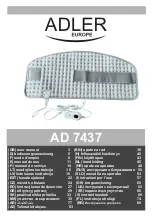
Outdoor Patio Heater
8
Operating Instructions and Owner’s Manual
HEATER MOUNTING INSTRUCTIONS
After selecting the heater installation location and after verifying and
ensuring that all of the above placement requirements are fulfilled,
mount the heater as follows:
1. The wall mounting must be carried out using anchors adapted to
the wall on which the heater will be installed. The use of dowels
with 3/8 “diameter is recommended. The surface on which it is
installed must be solid and suitable to support the weight of the
unit.
2. Position the heater as shown in Figure 8 and Figure 9 and slide
the heater mounting clip over the bracket and install the bolt
through the clip and bracket.
3. Thread the hex nut onto the bolt and tighten securely.
GAS SUPPLY INSTALLATION
INSTRUCTIONS
CONNECTING HEATER TO GAS SUPPLY
WARNING: Depending on local codes and requirements and
the installer’s skill level, the sizing and installation of gas
lines required to safely and efficiently supply the heater may
require the assistance of a professional. If in doubt as to
these requirements, discuss the requirements of this manual
with the dealer from whom the heater was purchased and
your gas supplier.
Locate the hose out of pathways where people may trip
over it or out of areas where the hose may be subject to
accidental damage.
Gas Supply Requirements
•
See Table 1 for gas supply minimum, maximum, operating, and
manifold pressures for both heater models. Pressures are provided
in inches of W.C. (water column). Also, see heater rating plates
located on the heater.
WARNING: These patio heaters burn natural gas or
liquefied petroleum (LP) gas and they come equipped with
a regulator. The regulator is built into the gas valve. The
maximum inlet pressure to this regulator is 14 in. W.C.. If
gas line pressure exceeds 14 in. W.C., then an additional
regulator must be installed before the heater/regulator to
step down the pressure to a maximum of 14 in. W.C..
Piping Requirements
All piping installed must comply with local codes and ordinances or
with National Fuel Gas Code, ANSI Z223.1 (NFPA 54), whichever takes
precedence. When installing piping, the following requirements must
be taken into consideration:
•
Canadian installations must comply with the B149.1.2 Gas Code.
•
Use new properly reamed black pipe free from chips.
•
Apply a good quality pipe compound to all male threads prior
to assembly. If LP gas is the fuel, ensure that pipe compound is
resistant to LP gas. Do not use Teflon™ tape.
•
A sediment trap shall be installed in the line to the gas valve.
•
A dedicated shut-off valve for the heater must be installed in the
gas supply line.
Piping Installation
WARNING: The gas hose must be positioned in such a
way that it does not trip people or create other accidental
damages.
While ensuring that all of the above gas supply requirements and
piping requirements are fulfilled, install piping as follows:
Gas Connection 1/2”
Inlet pressure - unscrew
this screw to measure
pressure of the gas line.
Manifold pressure -
Unscrew this screw before
operation then measure
only when the burner is ON
Measure pressure regulation - Remove the cap with a slotted
screwdriver: turn clockwise to increase pressure; turn count-
er-clockwise to decrease pressure.
Unit Gas Connection
FIGURE 10
a. In accordance with the above piping requirements, assemble
piping, sediment trap, shut-off valve, and necessary fittings.
Tighten all components securely.
WARNING: Failure to ensure that male threads on pipe to be
installed into gas valve meet the requirements may cause
gas valve damage, distortion and malfunction.
b. Install a threaded nipple into the gas valve.
c. Connect gas piping to nipple installed in the gas valve.
d. Ensure the building is properly ventilated. Without lighting the
burner of the heater, open the gas supply valve and pressurize the
piping up to the heater’s gas valve.
WARNING: When testing gas piping use only a soap and
water solution. Do not use a match or other flame for leak
testing. If during leakage check gas is smelled, turn off the
gas supply and ventilate building.
e. Using a brush, apply a soap and water solution to all connections
and look for bubbles indicating a leak. If a leak is detected,
turn off gas supply and tighten connections. Retest and tighten
connections.
Содержание HSRP37GL
Страница 16: ...Outdoor Patio Heater 16 Operating Instructions and Owner s Manual Electrical Diagram FIGURE 23...
Страница 60: ...Chauffe terrasse pour l ext rieur 16 Mode d emploi et guide du propri taire Diagramme lectrique FIGURE 23...
Страница 66: ...Chauffe terrasse pour l ext rieur 22 Mode d emploi et guide du propri taire NOTES...
Страница 67: ...Chauffe terrasse pour l ext rieur 23 Mode d emploi et guide du propri taire NOTES...









































